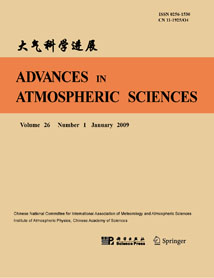| [1] |
Bohua Huang, James L. Kinter III, Paul S. Schopf,
2002: Ocean Data Assimilation Using Intermittent Analyses and Continuous Model Error Correction, ADVANCES IN ATMOSPHERIC SCIENCES, 19, 965-992.
doi: 10.1007/s00376-002-0059-z
|
| [2] |
Chaoqun MA, Tijian WANG, Zengliang ZANG, Zhijin LI,
2018: Comparisons of Three-Dimensional Variational Data Assimilation and Model Output Statistics in Improving Atmospheric Chemistry Forecasts, ADVANCES IN ATMOSPHERIC SCIENCES, 35, 813-825.
doi: 10.1007/s00376-017-7179-y
|
| [3] |
Xinrong WU, Shaoqing ZHANG, Zhengyu LIU,
2016: Implementation of a One-Dimensional Enthalpy Sea-Ice Model in a Simple Pycnocline Prediction Model for Sea-Ice Data Assimilation Studies, ADVANCES IN ATMOSPHERIC SCIENCES, 33, 193-207.
doi: 10.1007/s00376-015-5099-2
|
| [4] |
Banglin ZHANG, Vijay TALLAPRAGADA, Fuzhong WENG, Jason SIPPEL, Zaizhong MA,
2016: Estimation and Correction of Model Bias in the NASA/GMAO GEOS5 Data Assimilation System: Sequential Implementation, ADVANCES IN ATMOSPHERIC SCIENCES, 33, 659-672.
doi: 10.1007/ s00376-015-5155-y
|
| [5] |
Qizhen SUN, Timo VIHMA, Marius O. JONASSEN, Zhanhai ZHANG,
2020: Impact of Assimilation of Radiosonde and UAV Observations from the Southern Ocean in the Polar WRF Model, ADVANCES IN ATMOSPHERIC SCIENCES, 37, 441-454.
doi: 10.1007/s00376-020-9213-8
|
| [6] |
Zhiyong MENG, Eugene E. CLOTHIAUX,
2022: Contributions of Fuqing ZHANG to Predictability, Data Assimilation, and Dynamics of High Impact Weather: A Tribute, ADVANCES IN ATMOSPHERIC SCIENCES, 39, 676-683.
doi: 10.1007/s00376-021-1362-x
|
| [7] |
ZHENG Xiaogu, WU Guocan, ZHANG Shupeng, LIANG Xiao, DAI Yongjiu, LI Yong, ,
2013: Using Analysis State to Construct a Forecast Error Covariance Matrix in Ensemble Kalman Filter Assimilation, ADVANCES IN ATMOSPHERIC SCIENCES, 30, 1303-1312.
doi: 10.1007/s00376-012-2133-5
|
| [8] |
Jidong GAO, Keith BREWSTER, Ming XUE,
2006: A Comparison of the Radar Ray Path Equations and Approximations for Use in Radar Data Assimilation, ADVANCES IN ATMOSPHERIC SCIENCES, 23, 190-198.
doi: 10.1007/s00376-006-0190-3
|
| [9] |
Sibo ZHANG, Li GUAN,
2017: Preliminary Study on Direct Assimilation of Cloud-affected Satellite Microwave Brightness Temperatures, ADVANCES IN ATMOSPHERIC SCIENCES, 34, 199-208.
doi: 10.1007/s00376-016-6043-9
|
| [10] |
GAO Feng*, Peter P. CHILDS, Xiang-Yu HUANG, Neil A. JACOBS, and Jinzhong MIN,
2014: A Relocation-based Initialization Scheme to Improve Track-forecasting of Tropical Cyclones, ADVANCES IN ATMOSPHERIC SCIENCES, 31, 27-36.
doi: 10.1007/s00376-013-2254-5
|
| [11] |
Zhu Jiang, Wang Hui, Masafumi Kamachi,
2002: The Improvement Made by a Modified TLM in 4DVAR with a Geophysical Boundary Layer Model, ADVANCES IN ATMOSPHERIC SCIENCES, 19, 563-582.
doi: 10.1007/s00376-002-0001-4
|
| [12] |
Yong LI, Siming LI, Yao SHENG, Luheng WANG,
2018: Data Assimilation Method Based on the Constraints of Confidence Region, ADVANCES IN ATMOSPHERIC SCIENCES, 35, 334-345.
doi: 10.1007/s00376-017-7045-y
|
| [13] |
FU Weiwei, ZHOU Guangqing, WANG Huijun,
2004: Ocean Data Assimilation with Background Error Covariance Derived from OGCM Outputs, ADVANCES IN ATMOSPHERIC SCIENCES, 21, 181-192.
doi: 10.1007/BF02915704
|
| [14] |
Banglin ZHANG, Vijay TALLAPRAGADA, Fuzhong WENG, Jason SIPPEL, Zaizhong MA,
2015: Use of Incremental Analysis Updates in 4D-Var Data Assimilation, ADVANCES IN ATMOSPHERIC SCIENCES, 32, 1575-1582.
doi: 10.1007/s00376-015-5041-7
|
| [15] |
Fuqing ZHANG, Meng ZHANG, James A. HANSEN,
2009: Coupling Ensemble Kalman Filter with Four-dimensional Variational Data Assimilation, ADVANCES IN ATMOSPHERIC SCIENCES, 26, 1-8.
doi: 10.1007/s00376-009-0001-8
|
| [16] |
Xiaogu ZHENG,
2009: An Adaptive Estimation of Forecast Error Covariance Parameters for Kalman Filtering Data Assimilation, ADVANCES IN ATMOSPHERIC SCIENCES, 26, 154-160.
doi: 10.1007/s00376-009-0154-5
|
| [17] |
Linbin He, Weiyi Peng, Yu Zhang, Shiguang Miao, Siqi Chen, Jiajing Li, Duanzhou Shao, Xutao Zhang,
2024: Comparison of Adaptive Simulation Observation Experiments of the Heavy Rainfall in South China and Sichuan Basin, ADVANCES IN ATMOSPHERIC SCIENCES.
doi: 10.1007/s00376-024-3114-1
|
| [18] |
Xiaoli XIA, Jinzhong MIN, Feifei SHEN, Yuanbing WANG, Chun YANG,
2019: Aerosol Data Assimilation Using Data from Fengyun-3A and MODIS: Application to a Dust Storm over East Asia in 2011, ADVANCES IN ATMOSPHERIC SCIENCES, 36, 1-14.
doi: 10.1007/s00376-018-8075-9
|
| [19] |
Yaodeng CHEN, Jie SHEN, Shuiyong FAN, Deming MENG, Cheng WANG,
2020: Characteristics of Fengyun-4A Satellite Atmospheric Motion Vectors and Their Impacts on Data Assimilation, ADVANCES IN ATMOSPHERIC SCIENCES, 37, 1222-1238.
doi: 10.1007/s00376-020-0080-0
|
| [20] |
Guifu ZHANG, Jidong GAO, Muyun DU,
2021: Parameterized Forward Operators for Simulation and Assimilation of Polarimetric Radar Data with Numerical Weather Predictions, ADVANCES IN ATMOSPHERIC SCIENCES, 38, 737-754.
doi: 10.1007/s00376-021-0289-6
|















 AAS Website
AAS Website 
 AAS WeChat
AAS WeChat 
 DownLoad:
DownLoad: